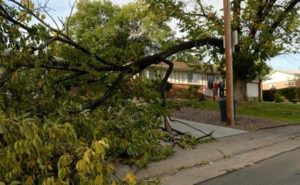From the DNR: Advice for dealing with storm damaged trees

Cleanup following a storm can be an overwhelming task for homeowners. Knowing which trees to save and which to remove can impact safety and the survival of remaining trees, according to the Minnesota Department of Natural Resources.
DNR forestry outreach specialist Jennifer Teegarden offers the following tips.
Do:
- Approach damaged trees with caution. Stay clear of downed wires and call 911.
- Carefully inspect standing trees for damage and deal with hazardous trees first. If possible, ask a forester or arborist for advice.
- Trees should be removed if more than 50 percent of the trunk or live branches in the crown are damaged, and if the tree is unnaturally leaning or roots are damaged.
- Watch for detached branches, loosely hanging branches and split or cracked trunks that can cause injury or further damage.
- Use proper pruning techniques to remove broken limbs by cutting just outside the branch collar, but limit pruning to making the tree safe. Too much pruning can weaken an already stressed tree.
- Water stressed and damaged trees weekly to help them repair and rebuild. Be careful not to overwater, especially in heavy clay soils.
- Monitor damaged trees in upcoming years to make sure they don’t become a hazard.
Don’t:
- Be rushed by promises of bargains from inexperienced or unqualified tree service providers. Improper pruning or unneeded removal can result in unnecessary costs or loss of healthy trees. Ask for references and proof of insurance.
- Repair a broken branch or fork of a tree with tape, wire, bolts or other wraps. It will not heal, and the split will invite decay and further weaken the tree. Cabling or bracing should only be performed by a certified arborist and inspected annually.
- Remove the tops of trees. This makes the tree more susceptible to insects and disease, and results in new branches that are weakly attached.
- Apply paint or dressing to wounds as these materials interfere with the natural wound sealing process.
- Remove small, leaning trees. Trees less than 15 feet tall may survive if they are gently pulled back into place. Press out air spaces in the loosened soil. The tree can then be staked for up to a year.
- Fertilize stressed or damaged trees.
Information on tree care, proper pruning techniques and handling damaged trees is available on the DNR website atwww.mndnr.gov/treecare/maintenance/stormdamage-prevention.html.
For more extensive information on tree care, contact a DNR forester, city forester, certified arborist or countyExtension staff.
Take the right steps to correct damaged trees so they can continue to provide shade, clean air, beauty and increased property value for many years to come.
